
Jul 17, 2020
SteamVR - joe
If you encounter issues with this update, please post in the SteamVR Bug Report forum. If possible, please include a system report to aid in tracking down your issue. Replies to this post are not tracked for bug reporting purposes. Please use the forum linked above to report issues.
OpenXR:
SteamVR Input:
OpenXR:
- Added support for using SteamVR from inside app containers. This permits WebXR content from Chrome and UWP OpenXR apps to use SteamVR.
- Fixed grip action space transforms on Index Controllers and Vive Controllers.
- Fixed vector2 actions not binding properly.
- Fixed tracking properties returned by xrGetSystemProperties always being false.
- Added a display of the current OpenXR runtime to the Developer settings, along with a button to set SteamVR as the current runtime.
SteamVR Input:
- Improved error reporting for developers when action manifest files and binding files have parse errors.





